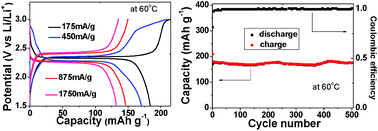A novel Li4Ti5O12-based high-performance lithium-ion electrode at elevated temperature†
Abstract
Destructive gas generation with associated swelling has been the major challenge for the large-scale application of Li4Ti5O12 (LTO)-based lithium-ion batteries (LIBs), especially when the LIBs work at high temperature. Here we report a new kind of Li4Ti5O12–rutile TiO2 (LTO–RTO) hybrid nanowire array electrode that can be cycled at elevated temperatures. After assembling the optimized LTO–RTO hybrid array as the anode and commercial LiCoO2 (LCO) film as the cathode, the obtained lithium-ion full cell exhibits outstanding performance with an ultralong lifetime at 60 °C (∼83.6% of its initial capacity can be retained at the end of 500 cycles at ∼2.5 C). Based on comparative experiments, we proposed a reasonable mechanism and, further, provided a reasonable verdict about the gas generation: the H2 and CO generation from the LTO electrode are significantly associated with the (111) facet. The presence of more LTO (400) planes than (111) ones in the optimized LTO–RTO electrode is the essential reason for long-term cycling at 60 °C without gassing. Our work implies that an ability to tune the crystal facet orientation of electrode nanostructures will be meaningful in the practical design of next-generation high-stability LIBs.

- This article is part of the themed collection: 2015 Journal of Materials Chemistry A Hot Papers

 Please wait while we load your content...
Please wait while we load your content...